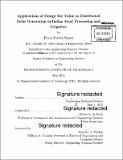| dc.contributor.advisor | Olivier L. de Weck. | en_US |
| dc.contributor.author | Simon, Kevin Patrick | en_US |
| dc.contributor.other | Massachusetts Institute of Technology. Engineering Systems Division. | en_US |
| dc.coverage.spatial | a-ii--- | en_US |
| dc.date.accessioned | 2016-01-15T21:10:23Z | |
| dc.date.available | 2016-01-15T21:10:23Z | |
| dc.date.copyright | 2015 | en_US |
| dc.date.issued | 2015 | en_US |
| dc.identifier.uri | http://hdl.handle.net/1721.1/100880 | |
| dc.description | Thesis: S.M., Massachusetts Institute of Technology, Engineering Systems Division, 2015. | en_US |
| dc.description | Cataloged from PDF version of thesis. | en_US |
| dc.description | Includes bibliographical references (pages 121-124). | en_US |
| dc.description.abstract | Solar panels are not installed on an off-grid farm to save on home energy bills. Those systems are installed to enable communities to do activities that they could not do before. This thesis studies the application of design for value to distributed solar energy systems by considering how the energy system will enable new income generating activities. The work here couples business and energy models to optimize with value as an objective function. The interaction between energy production and value creation is complex, so multi-objective optimization is used as a tool to explore the design space and analyze the feasibility of such projects. This methodology is practiced in two case studies. One case study considers the design of a solar irrigation pump that is specifically designed for marginal-holding farmers in east India. The other case study analyzes the feasibility of small-scale concentrated solar powered (p-CSP) food processing with an organic Rankine cycle (ORC). In both cases, preliminary economic feasibility is established with the use of analysis by optimization and design for value. It was found that a solar pump could be produced which costs less than 500 USD cap-ex and meets 99% of a marginal-holding farmer's water demand. The solar food processing analysis showed that a system could be produced which costs 29,000 USD with a 15-year NPV of 33,400 USD at a discount rate of 18%. The programmatic tools that are used to explore this design space include genetic algorithms, pattern search, adaptive weighted sums, and Pareto fronts. | en_US |
| dc.description.statementofresponsibility | by Kevin Patrick Simon. | en_US |
| dc.format.extent | 124 pages | en_US |
| dc.language.iso | eng | en_US |
| dc.publisher | Massachusetts Institute of Technology | en_US |
| dc.rights | M.I.T. theses are protected by copyright. They may be viewed from this source for any purpose, but reproduction or distribution in any format is prohibited without written permission. See provided URL for inquiries about permission. | en_US |
| dc.rights.uri | http://dspace.mit.edu/handle/1721.1/7582 | en_US |
| dc.subject | Engineering Systems Division. | en_US |
| dc.title | Applications of design for value to distributed solar generation in Indian food processing and irrigation | en_US |
| dc.type | Thesis | en_US |
| dc.description.degree | S.M. | en_US |
| dc.contributor.department | Massachusetts Institute of Technology. Engineering Systems Division | |
| dc.identifier.oclc | 933609271 | en_US |
